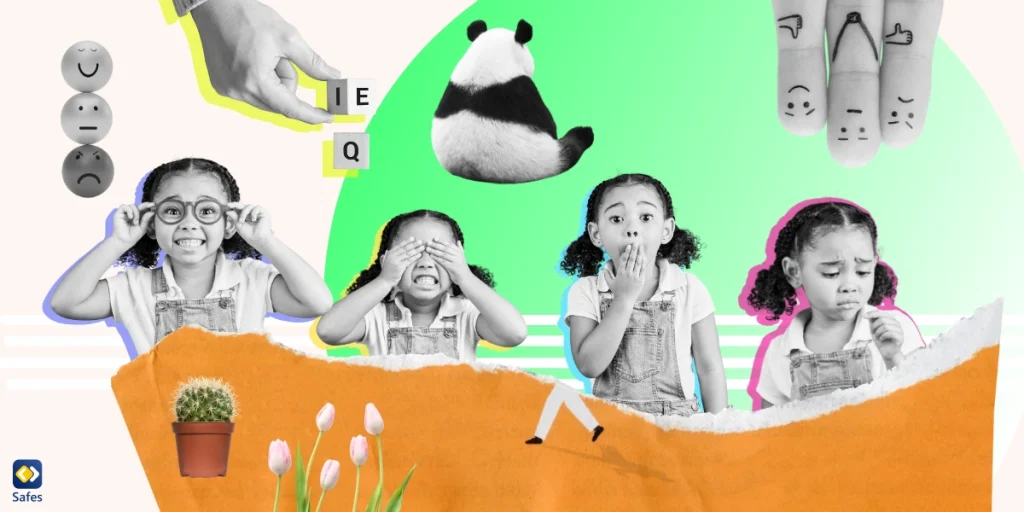Although it’s sometimes neglected, one of the most critical skills any parent can teach their child is how to manage their emotions. Why is emotional management so important? Because whether sad, angry, or anxious, learning to express and regulate your feelings healthily can bring about success in all areas of life. For this reason, we’ve put together this article to help you teach your child how to manage emotions. We’ll discuss the benefits of being able to manage emotions and how you can nurture this skill in your child. We’ll also tell you about the importance of parental control for supporting children’s emotional well-being online. So, as always, follow through.
Download and Start Your Free Trial of the Safes Parental Control App
How to Get in Touch with Your Emotions
Empowering your little one with the skills to face and master their emotions can equip them to thrive amidst challenges, nurture prosperous relationships, and lead enriched lives. Psychology experts uphold that learning to navigate emotions during their formative years can profoundly influence their triumphs and happiness in their future. To delve deeper into this intriguing subject, do explore this research paper: Strengthening Emotional Development and Emotion Regulation in Childhood—As a Key Task in Early Childhood Education
One of the first steps to managing emotions is learning to connect with your feelings. Many children struggle to identify and articulate feelings, leading to confusion, frustration, and behavioral issues. As a parent, so before anything, you have to create a safe and supportive environment where your child can feel comfortable expressing themselves. And that’s what we’ll discuss next.
Creating a Safe and Supportive Environment
To foster an environment of trust and support for your child, it’s essential to establish a strong connection. This involves being entirely present, showing attentiveness, and demonstrating understanding. Absorb every word they share about their emotions and reciprocate with empathy.
Further, positive acknowledgment can serve as a powerful tool to endorse emotional articulation and exemplify constructive interpersonal behavior. Applaud your child whenever they open up about their feelings, and occasionally, don’t hesitate to reveal your own emotions. For instance, if you’re unable to locate your keys, you might say, “I feel a bit frustrated when I can’t find my keys, but I realized getting upset won’t make them appear.”

Managing Emotions in a Positive Way
When your little one begins to grasp their emotions, it’s an excellent time to guide them towards handling these feelings in a positive light. You can introduce them to strategies like deep breathing, meditation, or visualizations as practical coping skills. Such methods can assist your child in maintaining emotional balance, while also minimizing stress and anxiety.
Another way to manage emotions is to encourage physical activity. Exercise releases endorphins, natural mood boosters that can help alleviate negative emotions. So, encourage your child to do physical activities they enjoy.
Ways to Manage Emotions
Guiding your child through the labyrinth of emotions can be a unique journey. Discovering the best method that resonates with your child is the key. Some children might find solace in confiding their feelings to a reliable adult or a close buddy. Yet, some children may gravitate towards releasing their emotions through creative avenues like art or music. As your trusty guide, we’ve curated some essential tips and strategies to help your child master their emotional world.
Strategies for Teaching Kids to Manage Their Emotions
Encourage open communication: Make sure your child knows they can talk to you about their feelings without fear of judgment or punishment. Listen actively and validate their emotions.
Model healthy emotional expression: Show your child how to express emotions healthily. For example, you might say, “I’m feeling angry right now, so I’m going to take a few deep breaths to calm down.”
Practice empathy: Help your child feel feelings; that means help them understand and appreciate the emotions of others. This can help them develop empathy and compassion, which in turn can help them manage their own feelings.
Use positive reinforcement: Praise your child when they handle their emotions well. It can help reinforce positive behavior and encourage them to continue.
Teach relaxation techniques: Help your child understand the benefits of relaxation techniques like deep breathing, meditation, or yoga. Encourage them to try these techniques as a way to manage stress and negative emotions.

Teaching Coping Skills
Teaching coping skills is also an essential aspect of managing emotions. Coping skills are techniques that help your child connect with their emotions and deal with difficult emotions and situations, including:
- Deep breathing
- Progressive muscle relaxation
- Visualization
- Positive self-talk
How to Control Your Emotions in the Moment
At times, your little one may encounter strong feelings like anger or sorrow right on the spot. When such instances arise, it’s crucial to guide them on handling their emotions adeptly. One proven method we advocate for is encouraging your child to inhale deeply and count to ten prior to responding. This simple yet powerful tactic aids in managing their emotions and sidestepping hasty or harmful actions.
Nurturing Emotional Intelligence
Emotional intelligence, the capacity to accurately recognize, comprehend, and manage our emotions, is an invaluable asset. This skill can equip your child to successfully traverse the intricate landscape of emotions and foster wholesome relationships.
You can cultivate this emotional acumen by guiding your child to embrace their emotions fearlessly. Teach them to pinpoint and articulate their feelings, sympathize with others, and efficiently control their emotional responses. In doing so, you’re giving them the keys to lead lives marked by gratification and productivity.
How Can Safes Protect Your Child’s Emotional Health?
The internet is full of risks that can threaten children’s emotional health. Cyberbullying, phishing, scams, and excessive screen time are only a few to mention. On top of teaching your child responsible digital behavior and helping them develop healthy relationships with technology, you can also use a parental control app such as Safes to protect them against these risks. These apps can help you monitor your child’s online activities, block inappropriate content, and limit screen time.
Using the Safes parental control app, you can create a safe and supportive environment for your child to explore the digital world. To learn how to put parental controls on Android, iOS, Windows, and Mac devices using Safes, follow the links below:
- Windows parental controls
- Macbook parental controls
- Parental controls on Android
- iPhone parental controls
Begin securing your child’s digital journey with Safes today—start your 14-day free trial and discover effective parental control options for various devices!
Conclusion: How to Manage Emotions in a Positive Way
As you now know, managing emotions is essential to your child’s emotional health and well-being. By creating a safe and supportive environment, teaching coping skills, and nurturing emotional intelligence, you can help your child develop the tools they need to manage their emotions effectively.
Teach your child how to get in touch with their emotions, allow themselves to feel them, and positively connect with them. By doing so, you can help them build healthy relationships, navigate challenging situations, and lead fulfilling lives.
Your Child’s Online Safety Starts Here
Every parent today needs a solution to manage screen time and keep their child safe online.
Without the right tools, digital risks and excessive screen time can impact children's well-being. Safes helps parents set healthy boundaries, monitor activity, and protect kids from online dangers—all with an easy-to-use app.
Take control of your child’s digital world. Learn more about Safes or download the app to start your free trial today!




